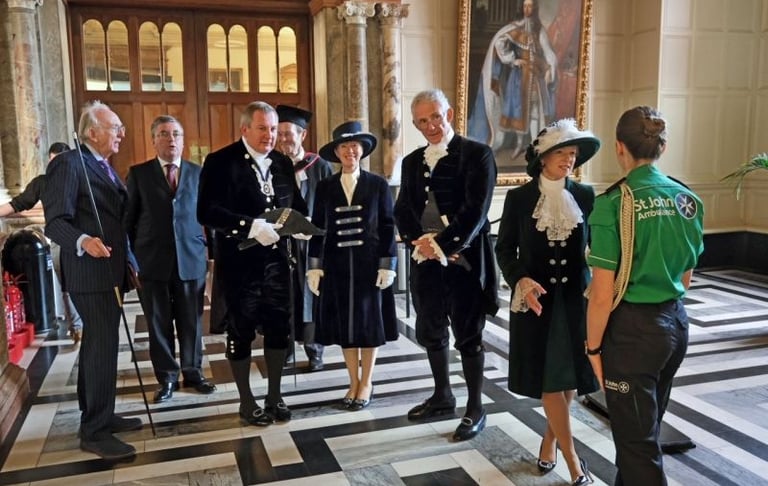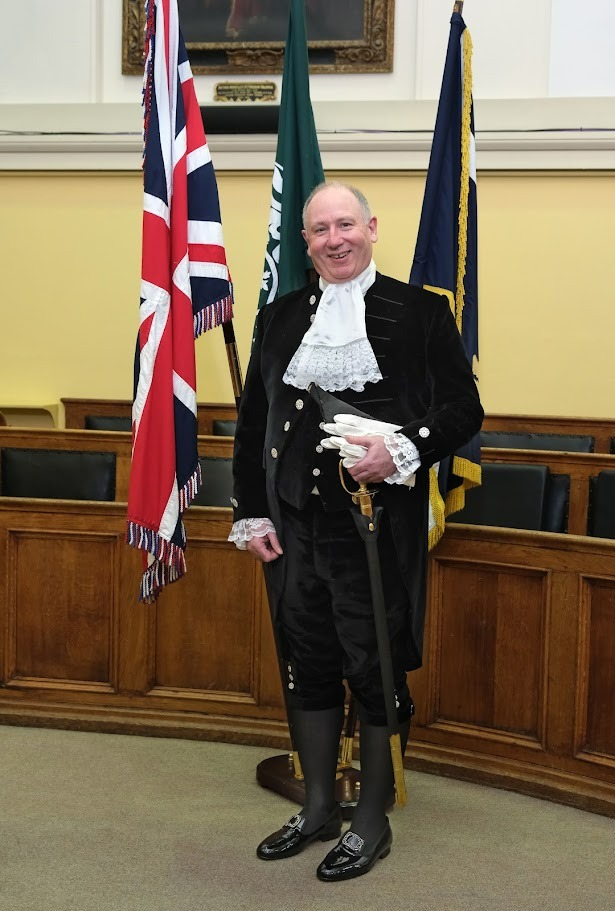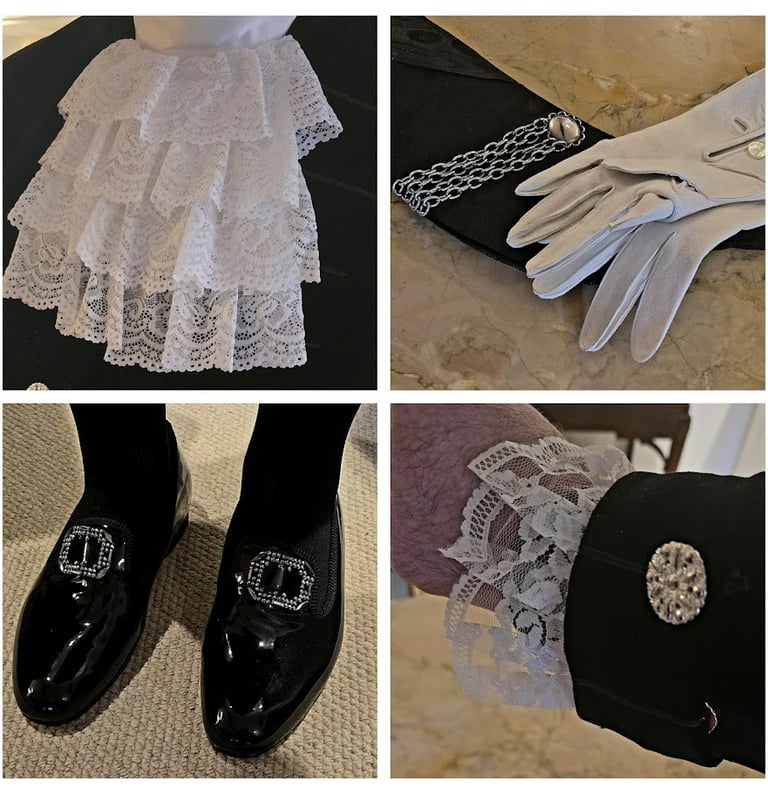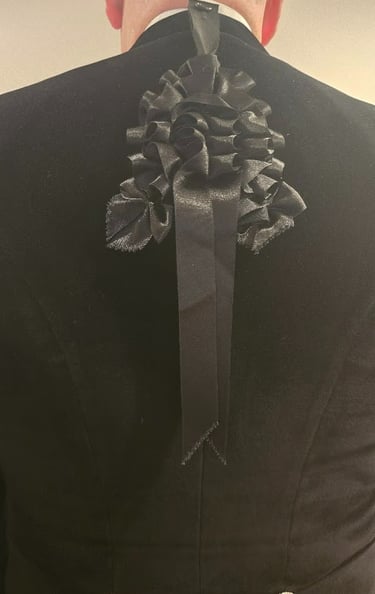The High Sheriff's Attire
The attire (or "rigging") worn by the High Sheriff varies according to the occasion. For non-ceremonial duties, such as presentations or formal visits to organisations within the county, the High Sheriff typically wears a formal suit, often complemented by the Badge of Office. Additionally, High Sheriffs may wear the High Sheriff’s Association tie.
For ceremonial events, the attire is far more formal, with the High Sheriff traditionally wearing Court Dress. This is a reflection of a time-honoured role, and while there is no official "Sheriff's uniform," the ceremonial outfit is instantly recognisable for its historic significance. Military uniform can also be worn if the High Sheriff is entitled.
Regulation Court Dress for High Sheriffs
The prescribed ceremonial dress for High Sheriffs in England and Wales is based on the 'old style' velvet Court Dress, which adheres to the following guidelines:
Coat:
Made of black or blue-black velvet, the coat features a stand collar and is cut in a pigeon-breasted style. It fastens with hooks and eyes at the breast, with seven buttons on the right side and corresponding false buttonholes on the left. Gauntlet cuffs feature three buttons, and the waist seam includes three-pointed pocket flaps. Six buttons adorn the back of the coat: two at the waist, two in the centre, and two at the skirt’s hem. The coat should be lined in black silk or artificial satin, with pockets at the breast and in the tails.
Buttons:
The buttons are made from cut steel, a highly sought-after material in the 18th and 19th centuries. Cut steel is steel that has been meticulously hand-faceted to catch and reflect light, producing a dazzling, gemstone-like effect. It was particularly prized in the fashion world due to its brilliance and craftsmanship, especially when more expensive materials were inaccessible. For the High Sheriff, these buttons add a dignified, traditional elegance.
Wig Bag:
A black silk wig bag, fastened to the coat’s back, is intended to hang over the collar.
Waistcoat:
The waistcoat can be made from black velvet or ivory satin, depending on the time of day. It is collarless, with four buttons at the front and pockets featuring three-pointed flaps, with a button beneath each point.
Breeches:
Black velvet breeches fasten at the knee with three small cut steel buttons and steel buckles.
Hose:
The hose are black, maintaining a simple and formal appearance.
Cocked Hat:
The chapeau bras is made of black plush, featuring a black silk cockade or rosette, with a cut steel loop and button for decoration. The hat is carried rather than worn.
Sword:
A sword with a cut steel hilt and mountings, accompanied by a black lacquered scabbard. The sword is suspended by either a black velvet frog or webbing slings, depending on the scabbard mounts.
Gloves:
White kid or cotton gloves are worn as part of the formal attire.
Shirt:
The shirt is plain with a white lawn or cambric stock fastened by studs, and features a lace fall at the front. Matching lace ruffles are sewn into the coat cuffs.
Court Dress for Lady Sheriffs
There are no strict regulations governing Court Dress for Lady Sheriffs, but the general recommendation is to wear an outfit made from black or blue velvet, styled at the wearer’s discretion. Ideally, the attire includes cut steel buttons, shoe buckles, and a black silk wig bag. Lady Sheriffs do not wear swords, but a cut steel sword may be carried before them by a cadet.
The Evolution of Court Dress
Court Dress has a long and storied history, evolving alongside royal court ceremonies. In 1869, the Lord Chamberlain's office issued new guidelines to standardise the appearance of gentlemen attending court, marking the introduction of what we now recognise as the 'old style' velvet Court Dress. The suit consists of black velvet, cut steel buttons, and is worn with a cocked hat. This uniform harks back to a time when court attire developed more slowly than fashion, resulting in a style rooted in the 18th century, even as it was worn in the 19th century.
A 'new style' Court Dress emerged later, featuring a bow tie rather than lace frills, but this version never became popular among High Sheriffs, who remained loyal to the older tradition. Female High Sheriffs have also adopted their own variation of Court Dress, often bespoke creations that maintain the dignified spirit of the role.
The wearing of Court Dress is not only a nod to tradition but also serves as a formal acknowledgement of the High Sheriff’s role as the Crown’s representative during Assizes. The tradition of High Sheriffs donning this ceremonial attire is a long-established custom, though variations such as military or Deputy Lieutenant uniforms have been noted throughout history. Today, the High Sheriffs’ Association encourages the wearing of Court Dress to uphold the dignity and recognition of the office during official engagements, though it remains up to the individual Sheriff to decide how to present themselves.








The Oxfordshire Shrievalty
Championing justice and community across Oxfordshire
© 2025. All rights reserved.
